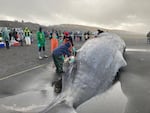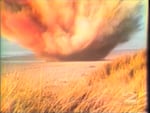Last Saturday, a nearly 40-foot sperm whale washed ashore in Oregon’s Fort Stevens State Park. After examining a large gash in the whale’s side, officials determined the animal died after being struck by a ship propeller.
James Powell is the Rescue and Response program manager for SR3 SeaLife Response, Rehabilitation, and Research, a nonprofit that supports organizations that respond to marine animal strandings in the Pacific Northwest. Powell helped determine the cause of death for the sperm whale and spoke with OPB’s “All Things Considered” host Crystal Ligori.
Related: Second dead whale found on northern Oregon Coast
Crystal Ligori: When animals wash ashore like this, who responds and what exactly do they do?
Powell: The United States is covered by a National Marine Mammal Stranding Network and there are different organizations throughout the country that cover different regions of the coastline. For this case, there’s an organization out of Portland State University that’s run by Dr. Deb Duffield called the Northern Oregon/Southern Washington Stranding Program and that’s their response region. And initially they have partners at Seaside Aquarium that will often get to the beach sooner to investigate the case and see what they’re working with and to secure the area. [They can] provide some on-the-ground information to the response team and then decisions are made on how to and when to safely respond to the case.

A team performs a necropsy on the carcass of a sperm whale on the northern Oregon Coast on Monday, Jan. 16, 2023. The body washed ashore two days earlier and the necropsy will determine the whale's cause of death.
Courtesy NOAA Fisheries
Ligori: How did you all determine what killed this whale?
Powell: When the whale was on the beach, there was a really obvious large open gash down the side of its body. So we were investigating that and some other associated external signs of trauma to determine what might have caused the injury and if the injury occurred while the animal was still alive or if it happened after the animal had already died at sea. So our team arrived and set a pretty big perimeter [with] the vehicles that we had, with our equipment, and around the animal just so we had a safe space to work. The animal was stranded in a very easily accessible part of the beach — right in the state park by a large parking lot — so there was a crowd of probably 100 people rotating there throughout the day that had come out to see the animal.
Ligori: Is that unusual to have folks essentially watching you do your job?
Powell: These animal [strandings] are kind of rare occurrences. I think the bigger the animal, the bigger the crowd it draws. There were people who reportedly came all the way from Portland just to see the animal. I think it’s a very rare and unique opportunity for the public to see these animals that are onshore and to firsthand appreciate their size and the things that we can learn from them.
Ligori: What else did the necropsy tell you about the whale?
Powell: Other than the cause of death, the other thing that we typically look for in this type of work is anything we can learn about the animals, especially when they become more rare and unique species. So we look for some life history samples to understand the development or age. And also the feeding ecology and nutritional status. We’re kind of looking for signs of underlying illness or other disease to see how healthy the animal was when it was still free swimming. Interestingly, the animal was pretty robust. It had a really thick blubber layer and we looked inside its stomach contents and there was quite a large number of squid beaks. So the animal had been feeding recently and actively when it was hit. So our finding showed the animal was not compromised [and] seemed otherwise healthy.
Ligori: How common is it for whale strandings to have a human cause like this one?
Powell: In Oregon and Washington, of the large whale strandings that we have, about 10% of those are human interaction. And then from those — and we have six large whale species off our coast — from those, about 20% of those are vessel collisions.
Ligori: Is it unusual for a sperm whale to still be off the Oregon coast at this time of year and not have already migrated south?
Powell: We don’t really know a lot about the migration behavior of sperm whales, especially compared to what we know about humpback whales and gray whales. Historically, Portland State’s response team has had six sperm whale [strandings] in their coverage area. And those have all been kind of from December 31st to early March, so this is the time of year historically when we’ve seen single sperm whale strandings on the Oregon coast. So I would say it’s uncommon. And then NOAA (National Oceanic and Atmospheric Administration) has reported a pretty remarkable shift in the squid population further north. In the last 2015 to 2020 timeframe, there’s been a marked increase in offshore squid. And so sperm whales are going to go where their primary food source is. So as that prey shifts, the whales will follow it, and so [the sperm whale] being there is probably not abnormal, we may just not know as much about that species as we do about humpback and gray whales.

A screenshot of the moment of detonation of the rotting sperm whale as capture by KATU on Nov. 12, 1970, in Florence, Ore.
Courtesy of KATU
Ligori: And now that you’ve determined the cause of death, what happens to the whale carcass? It’s hopefully not another exploding whale situation, right?
Powell: No, no, I don’t think the 1970 exploding whale is gonna repeat itself ever. The Oregon State Parks has jurisdiction over that and right now they’re gonna wait and see if the king tides can remove the carcass on its own naturally before they look at hiring someone to move or bury it. There was a sperm whale that washed up in almost the exact same spot at that state park in 2017 and a couple of tidal cycles pulled it offshore, which is part of the natural ecosystem. When large animals like that die, they’ll die and sink and contribute back to the natural cycle of things. So that’s hopefully what’s going to happen.
Ligori: Since this was something that was human-caused, are there things that we should be doing to prevent this?
Powell: One of the big limiting factors when it comes to sperm whales is that we just don’t know as much about them as we do other large whale species off our coast. You know when we know when and where large whale aggregations are, there can be communication between the biologists in the field through NOAA, they can communicate with the Coast Guard and send out the [information] to mariners and ships can slow down or avoid areas where there are whales. But as things shift and whales may be moving to follow prey, I think the limiting factor we have with sperm whales is we just don’t know as much about them as we do with the other species.




